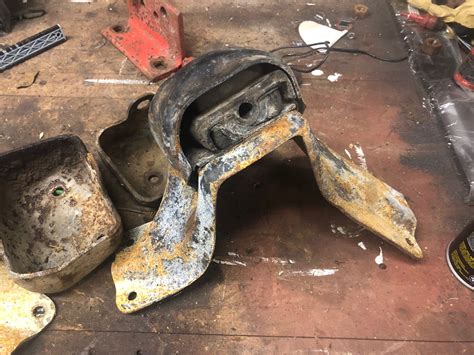Discover engine mounts: their functions, common issues, signs of failure, and when to replace them to ensure optimal vehicle performance.When it comes to maintaining your vehicle, one component that often goes overlooked is the engine mount. These critical parts play a vital role in ensuring your engine operates smoothly and effectively. Engine mounts serve as the connection between your engine and the car’s chassis, absorbing vibrations and keeping the engine securely in place. However, like all components, they can wear out over time, leading to potential issues that can affect your vehicle’s performance. In this blog post, we’ll explore what engine mounts are, their functions, common problems that arise with them, the signs indicating a failure, and essential tips for replacing them when necessary. Whether you’re a seasoned car enthusiast or a casual driver, understanding engine mounts is key to ensuring your vehicle runs at its best.
What are engine mounts?
Engine mounts are essential components in vehicles, serving as the critical interface between the engine and the vehicle’s chassis. Typically made from durable materials such as rubber and metal, these mounts are designed to absorb vibrations produced by the engine while simultaneously securing it in place to prevent movement during operation. Their strategic placement enables them to manage the weight and torque generated by the engine, ensuring a smooth and stable ride for passengers and minimizing stress on other components.
These mounts play a significant role not only in maintaining the overall integrity of the vehicle’s structure but also in enhancing passenger comfort by isolating vibrations and noise that originate from the engine compartment. Furthermore, the design of engine mounts can vary depending on the vehicle’s make and model, with some featuring additional components such as hydraulic cushioning systems that offer improved dampening capabilities for a more refined driving experience, especially in high-performance or luxury vehicles.
In essence, while engine mounts may seem like minor parts in the complex assembly of an automobile, they are indeed crucial for the seamless operation of the engine, making them an often-overlooked component that contributes significantly to the vehicle’s performance and longevity.
Functions of engine mounts
Engine mounts, which are crucial components in automotive engineering, serve several important functions that significantly contribute to the overall performance and longevity of a vehicle. The primary role of engine mounts is to secure the engine to the vehicle’s frame, ensuring that it remains in place during operation, while simultaneously absorbing vibrations produced by the engine, thereby minimizing noise and enhancing ride comfort for passengers.
Another significant function of engine mounts lies in their ability to accommodate the movement of the engine during its operation, allowing for thermal expansion and minimizing stress on the engine components. These mounts also play a critical role in reducing engine torque, which can lead to unnecessary strain on other parts of the vehicle’s drivetrain. Furthermore, they provide a stable platform for the transmission and other connected components, thus promoting efficient power transfer from the engine to the wheels.
In addition to the mechanical support, engine mounts also help to maintain the alignment of the engine and transmission with the vehicle’s driveline, ensuring proper engagement with both the transmission and driveshaft. Properly functioning engine mounts are essential for ensuring safety, as they prevent excessive engine movement that could potentially damage surrounding parts or even result in catastrophic failure, illustrating their vital importance in the realm of vehicle maintenance and operation.
Common issues with engine mounts
Engine mounts, often overlooked during routine maintenance, perform a crucial role in securing the engine to the chassis while also dampening vibrations and absorbing shock. However, over time, they can become worn or damaged due to a variety of factors including age, excessive heat, poor road conditions, and improper installation. One common issue is cracking or deterioration of the rubber material, which can lead to a significant loss of structural integrity, resulting in undesirable engine movement and increased vibration, which not only affects the driving experience but can also lead to further damage to other components of the vehicle.
Another prevalent issue with engine mounts is separation of the mount from its metal brackets, which can cause the engine to sit lower than intended or shift during acceleration or braking. This misalignment can create an uneven load on the mounting points, leading to premature wear on adjacent parts such as exhaust systems and drivetrains. It is crucial to identify this problem early to avoid costly repairs and maintain optimal vehicle performance.
Furthermore, fluid-filled mounts can develop leaks over time, leading to a loss of the damping properties that are critical for vibration control. When these mounts fail, the vehicle may exhibit increased noise and vibration, significantly impacting occupant comfort and the overall driving experience. Regular inspection and timely replacement of failed engine mounts can not only enhance performance but also extend the lifespan of your vehicle, making it imperative for all car owners to be aware of these common issues.
Signs of failing engine mounts
Engine mounts play a crucial role in the proper functioning of your vehicle, and when they begin to fail, it can lead to a variety of alarming symptoms that should not be ignored; therefore, recognizing the signs of failing engine mounts is essential for maintaining the integrity and safety of your automobile.
One of the most prevalent indicators of failing engine mounts is an increase in engine vibration, which can often be felt through the steering wheel or the vehicle’s floor, and these vibrations occur because the mounts are no longer able to absorb the natural oscillations produced by the engine, resulting in a rough ride that can cause further damage to other components.
In addition to heightened vibrations, drivers might also notice unusual noises, particularly during idling or when accelerating, as the failing engine mounts no longer secure the engine in place, allowing it to move excessively and create clunking or banging sounds; if you encounter any of these symptoms or experience a misalignment of the engine that affects your vehicle’s performance, it’s essential to consult a professional mechanic as soon as possible.
Replacing engine mounts
Replacing engine mounts is a crucial maintenance task for any vehicle owner seeking to ensure the longevity and performance of their engine, as these components play a vital role in securing the engine in place while also absorbing vibrations and reducing noise.
When it comes to the replacement of engine mounts, one must be equipped with the appropriate tools and knowledge to successfully undertake this endeavor, as the process typically involves lifting the engine, removing fasteners, and precisely positioning new mounts to ensure optimal alignment, which can significantly impact the vehicle’s handling and ride comfort.
Moreover, it is advisable to consult the manufacturer’s specifications for your specific vehicle model, as this will provide critical information regarding the correct torque settings and any additional parts that may need to be replaced during the process, thus ensuring that the new engine mounts function flawlessly and contribute to a smoother and quieter driving experience.
Frequently Asked Questions
What are engine mounts?
Engine mounts are mechanical components that secure the engine to the vehicle’s chassis, helping to absorb vibrations and support the engine’s weight.
Why are engine mounts important?
Engine mounts are important because they reduce engine vibrations, stabilize the engine under various conditions, and ensure proper alignment with other components such as the transmission.
What symptoms indicate a failing engine mount?
Symptoms of a failing engine mount may include excessive engine vibration, loud noises during acceleration, misalignment of the engine, or visible cracks and damage to the mounts.
How do I know if I need to replace my engine mounts?
You may need to replace your engine mounts if you notice increased vibration inside the cabin, unusual noises when driving, or if a mechanic identifies significant wear or damage during a routine inspection.
Can I replace engine mounts myself?
Yes, you can replace engine mounts yourself if you have the right tools and experience with mechanical work; however, it’s important to follow a repair manual specific to your vehicle.
How long do engine mounts typically last?
Engine mounts typically last between 5 to 10 years, but their lifespan can vary based on driving conditions, vehicle usage, and the quality of the mounts.
What type of materials are engine mounts made from?
Engine mounts are usually made from a combination of rubber, metal, and sometimes polyurethane, providing both flexibility and strength to absorb vibrations effectively.





